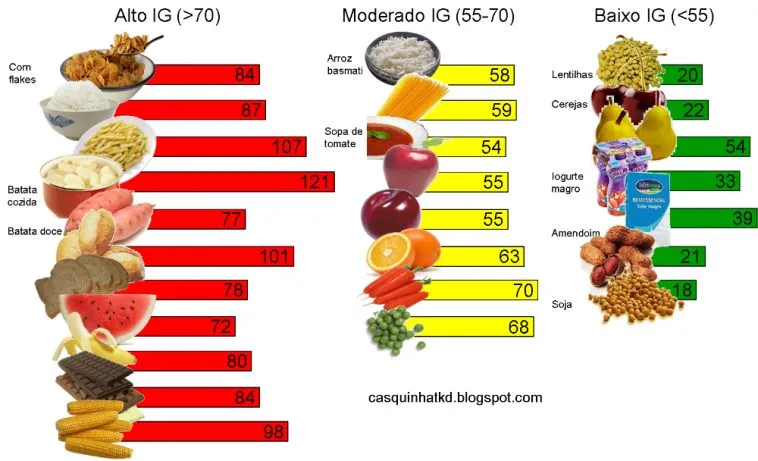The glycemic index (IG) is a scientific way to see how carbohydrates in food affect our blood glucose levels.
Scientists know that all carbohydrates have this rise effect on our blood glucose but the glycemic index goes further and analyzes how a specific food raises these levels.
The concept of glycemic index (IG) was introduced byJenkins and Cols.At the beginning of the last century as a carbohydrate classification system based on its immediate effect on glucose levels.
The IG of a large amount of food has been determined in order to classify them according to different categories.Low glycemic foods are the best for those who live with diabetes because there will be less effect on blood glucose levels.
There are other factors that vary the IG of a food: the type of starch, dietary fiber, cooking time, food temperature, physical shape (chopped, ground, etc.), among others.
Therefore, good clinical judgment is very important to give practical utility to the IG, since it suggests applying this concept in foods that are consumed as refrigerations or collations.
Not only should the IG of a food be considered to recommend it, as there are foods with a high sugar content or with high HCO content and fats that are low IG but are not appropriate for their high energy density, especially in people with diabetesThey present overweight or obesity.
On the other hand, the IG does not consider the total amount of HCO consumed.
Diabetes Tipo 1 desde 1.998 | FreeStyle Libre 3 | Ypsomed mylife YpsoPump + CamAPS FX | Sin complicaciones. Miembro del equipo de moderación del foro.
Autor de Vivir con Diabetes: El poder de la comunidad online, parte de los ingresos se destinan a financiar el foro de diabetes y mantener la comunidad online activa.
I was reading this and it seemed useful to expand the above and make fewer errors in our food
Link
I hope it was useful for me it was very simplified the concepts about the IG and after reading I realized the reason for some climbs of my glycemia due to the preparation of food is very clear to understand how to approach a foodmore correct possible
Diabetes 2, pero insulinorequiriente, con resistencia a la insulina y pancreas agotado.
HbA1c: dic '16: 12,8; mar '17: 10,9
Fallece mi madre oct '17
Ida a Paraguay feb '18
HbA1c: oct '18: 8,7; ene '19: 6,5; abr '19: 6,2 abr '19: 6,5; jun '19: 7,5; set '19: ???
Detemir 26 7:30 y 20 19:30
Aspartica 4 antes desay y mer y 5 antes alm y cena.
200 a 250gr de HC diarios, 80gr Prot y 80gr Grasa. Segun actividad.
71 años 88kg 1,72.
RAKE
07/31/2017 11:59 p.m.
Sandia has a high glymic index?If it is water.
I imagine it is a small failure.
DM1 desde 1992, con 9 añitos; Tresiba 10, Apidra en función de HC
Freestyle Libre
rake said:
Sandia has a high glycemic index?If it is water.
I imagine it is a small failure.
It is not failure.Has a very high index
No signature configured, add it on your user's profile.
@Mario69, in the link that you put says that frozen and defrosting bread at room temperature has a lower glycemic index.
I didn't know., and we do so in my house.
Hija de 35 años , diabética desde los 5. Glico: normalmente de 6 , pero 6,7 la última ( 6,2 marcaba el Free)
Fiasp: 4- 4- 3 Toujeo: 20
Dear companions:
It is clear that analyzing the carbohycemic index is very orientative of the effect of a diet on glycemia.However, within the carbohydrates that circulate through blood different from glucose with a crucial effect on the acute and chronic complications of diabetes are the galactose that comes from milk, mainly, and fructose that comes from sugar orFruits
In my experience, fruit fructose affects the control of diabetes such as sugar;Although, scientific studies do not relate fruit consumption to diabetes complications.I tell you my experience.
No signature configured, add it on your user's profile.
Estimated Joselui:
The watermelon has glucose, hence the carbohymic index, and fructose that does not come out in the measurement of blood glucose.The glucometer measures glucose but I don't know what happens with other simple, galactose and fructose sugars.
Do you know?
No signature configured, add it on your user's profile.
I will be weird ... because rice and watermel
No signature configured, add it on your user's profile.
Since I buy comprehensive rice I have quite controlled rice peaks.
No signature configured, add it on your user's profile.
@"Isma", lactose, is a complex sugar in whose composition there is glucose.
The galactose is transformed into glucose in the liver.
And fructose is simple sugar that is more slowly absorbed than glucose, but also transforms into glucose.
Sucrose has glucose and fructose.
Hija de 35 años , diabética desde los 5. Glico: normalmente de 6 , pero 6,7 la última ( 6,2 marcaba el Free)
Fiasp: 4- 4- 3 Toujeo: 20
Sucrose has fructose and glucose ..
Hija de 35 años , diabética desde los 5. Glico: normalmente de 6 , pero 6,7 la última ( 6,2 marcaba el Free)
Fiasp: 4- 4- 3 Toujeo: 20
@"Isma", here are an article from a biologist where he explains in detail how fructose is metabolized:
Link
DM1 desde 2003 | Toujeo + Humalog | FreeStyle 2 | HbA1c 5.5
Estimated Regina:
What happens to the galactose that does not metabolize in the liver and transforms into glucose?
It is eliminated by urine, for feces, where is it going?
Forgive my awkwardness.
No signature configured, add it on your user's profile.
Fructose differs from glucose in how it is metabolized.In the end most end in the blood as a glucose as far as I know (someone corrects me if not).That is why blood glucose elevates you later than pure glucose, needs to be metabolized in the liver to become glucose.
It is normally present in the fruit and when carrying fiber, absorption is also slowed (provided that the whole fruit and not just juice are consumed).
Lately they also use it to edulzar soft drinks and other products with added sugar.The high fructose corn syrup is used, which is basically the fructose obtained from corn.
It has also begun to sell as a substitute for sugar and is sometimes sold as "suitable for diabetics" or similar.This is pure marketing, both glucose and fructose raise blood sugar and diabetics we have to control it.
So I have read it consumed in fruit form is not a problem, you are not able to eat a lot of blow, the fiber makes it absorb slowly and does not cause problems.
Consumed in the form of sugar added to sodas, especially if it has been related to long -term health problems (obesity, metabolic syndrome, fatty liver, diabetes ...) is a lot of blow and there is no fiber that makes it makeabsorb more slowly.It is overloaded to the liver to process it, then the blood sugar rises sharply ...
There are also people who are fructose intolerant and have trouble metabolizing it so they have to eliminate it from the diet.
DM1 desde 2003 | Toujeo + Humalog | FreeStyle 2 | HbA1c 5.5
I suppose it is eliminated by the intestine, as with lactose when it does not metabolize, if there is intolerance.
Hija de 35 años , diabética desde los 5. Glico: normalmente de 6 , pero 6,7 la última ( 6,2 marcaba el Free)
Fiasp: 4- 4- 3 Toujeo: 20





